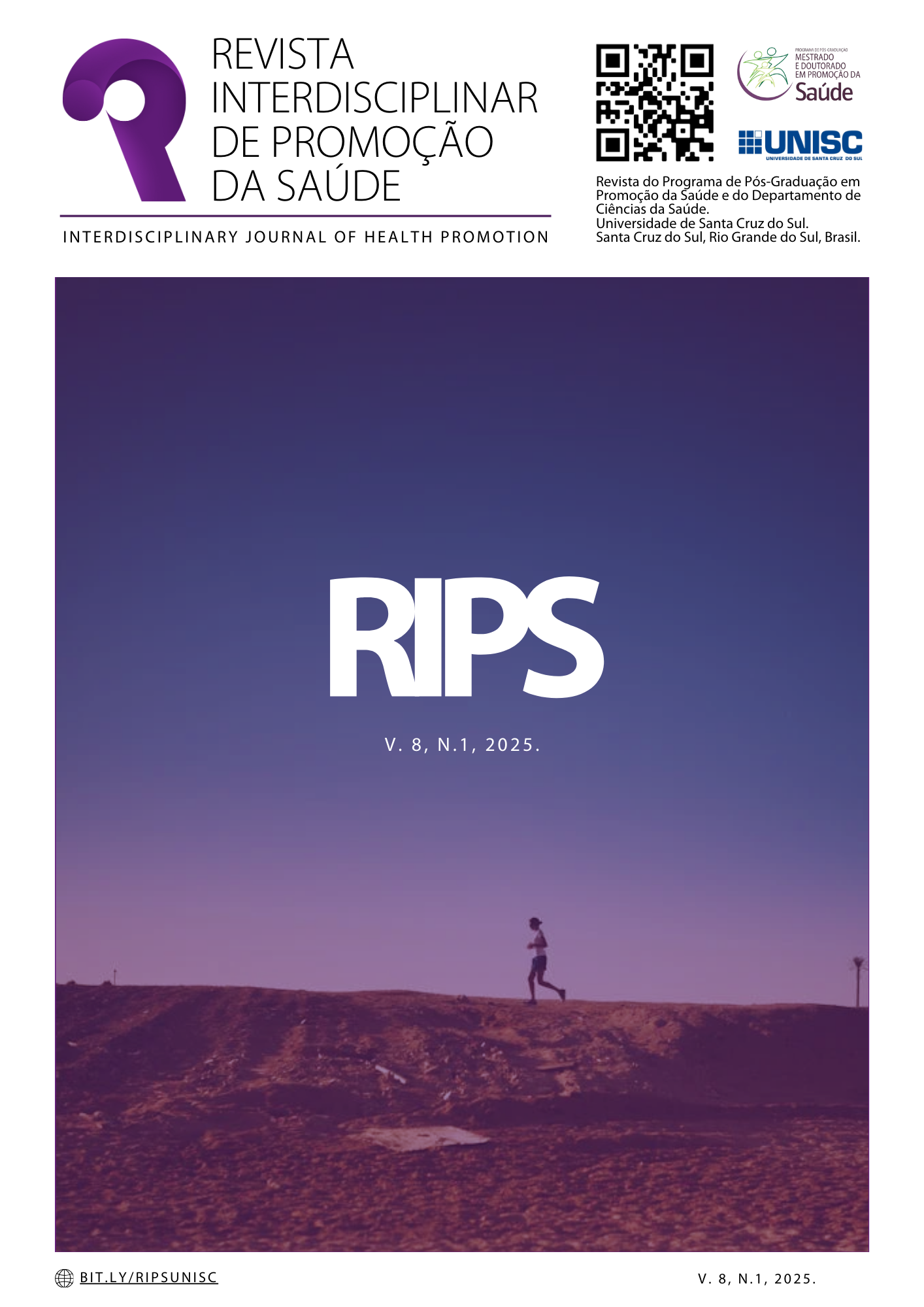EFEITO DO EXERCÍCIO FÍSICO NAS SEQUELAS CARDIOVASCULARES CAUSADA PELO SARS-CoV-2: um relato de caso
DOI:
https://doi.org/10.17058/rips.v8i1.18603Palavras-chave:
Covid-19, Relato de caso, Reabilitação, Exercícios físicosResumo
Introdução: a pandemia da Covid-19 teve um impacto significativo na saúde global, resultando em muitos pacientes apresentando sequelas pós-infecção, como problemas cardiovasculares e alterações hemodinâmicas. Essas condições são comumente relatadas em casos conhecidos como "Covid longa". O uso de exercícios físicos (EF) como parte da reabilitação tem se mostrado uma abordagem promissora para aliviar os sintomas persistentes após a infecção. Objetivo: avaliar o papel terapêutico do exercício sobre a hipertensão e a aptidão fisica como sequela pós infecção por SARS-CoV-2 Método: trata-se de um estudo de caso realizado com um paciente de 52 anos, encaminhado pela Secretaria de Saúde para dar continuidade ao tratamento com EF. O paciente foi submetido a uma anamnese clínica, na qual relatou sequelas pós-SARS-CoV-2, incluindo fadiga crônica e hipertensão arterial, e a uma avaliação física que incluiu medidas antropométricas (massa corporal, estatura, circunferência da cintura-CC), testes motores (abdominais, teste de caminhada de 6 minutos) e capacidade vital (espirometria). Em seguida, o paciente foi acompanhado individualmente por 90 dias em um programa de EF seguindo as evidências cientificas do American College Sports Medicine, realizado duas vezes por semana, com duração de 60 minutos por sessão. O programa incluiu atividades aeróbias e treinamento resistido como parte principal do tratamento. Resultados: após a conclusão do programa, o paciente relatou uma melhora na disposição (maior resistência), e foram observados aumentos na distância percorrida no teste de caminhada de 6 minutos (5%) e na capacidade vital (3%). Além disso, houve uma redução na massa corporal (3%), na CC (3%) e normalização da pressão arterial. Conclusão: esses resultados indicam que o programa de exercícios, realizado duas vezes por semana, durante 90 dias, demonstrou ser efetivo tanto em aspectos qualitativos (percepção do paciente) quanto em aspectos quantitativos (melhora no desempenho e redução de medidas de pressão arterial) em um indivíduo com sequelas cardiovasculares pós-Covid-19.
Downloads
Referências
Zhang JJ, Dong X, Cao YY, Yuan YD, Yang YB, Yan YQ, et al. Clinical characteristics of 140 patients infected with SARS-CoV-2 in Wuhan, China. Allergy 2020 Jul 1; 75(7):1730–41. doi: https://doi.org/10.1111/all.14238
Zhou, Y., Chi, J., Lv, W., & Wang, Y. Obesity and diabetes as high‐risk factors for severe coronavirus disease 2019 (Covid‐19). Diabetes Metab Res Rev 2021; 37(2):e3377. doi: https://doi.org/10.1002/dmrr.3377 PMID: 32588943
Sallis R, Young DR, Tartof SY, Sallis JF, Sall J, Li Q, et al. Physical inactivity is associated with a higher risk for severe COVID-19 outcomes: A study in 48 440 adult patients. Br J Sports Med 2021 Oct 1; 55(19):1099–105. doi: https://doi.org/10.1136/bjsports-2021-104080 PMID: 33849909
Saes MO. Covid longa. Vittalle. 2021; 33(3):7–8. doi: https://doi.org/10.14295/vittalle.v33i3.13833
Schwendinger F, Knaier R, Radtke T, Schmidt-Trucksäss A. Low Cardiorespiratory Fitness Post-COVID-19: A Narrative Review. Sports Med 2022 Sep 17; 53:51-74. doi: https://doi.org/10.1007/s40279-022-01751-7 PMID: 36115933
Sykes DL, Holdsworth L, Jawad N, Gunasekera P, Morice AH, Crooks MG. Post-COVID-19 Symptom Burden: What is Long-COVID and How Should We Manage It? Lung 2021 Apr 1; 199(2):113–9. doi: https://doi.org/10.1007/s00408-021-00423-z PMID: 33569660
Queiroga MR, Ferreira SA, Vaz EDS, Souza SCS, de Oliveira LEC, Stavinski NG de L, et al. Clínica e Academia Escola de Educação Física: prescrição de exercícios físicos baseados em evidências científicas. Extensio 2019 Aug 28; 16(33):111–22. doi: https://doi.org/10.5007/1807-0221.2019v16n33p111
American College of Sports Medicine. ACSM’s Guidelines for Exercise Testing and Prescription. 10th ed. Riebe D, Ehrman J k., Liguori G, Magal M, editors. Wolters Kluwer Health; 2018.
American Thoracic Society. ATS Statement: Guidelines for the Six-Minute Walk Test. Am J Respir Crit Care Med 2002; 166:111–7. doi: 10.1164/ajrccm.166.1.at1102
Pucci F, Annoni F, dos Santos RAS, Taccone FS, Rooman M. Quantifying renin-angiotensin-system alterations in covid-19. Cells. 2021 Oct 1; 10(10):2755 doi: https://doi.org/10.3390/cells10102755 PMID: 34685735
Tadic M, Saeed S, Grassi G, Taddei S, Mancia G, Cuspidi C. Hypertension and COVID-19: Ongoing Controversies. Front Cardiovasc Med 2021 Feb 17; 8. doi: https://doi.org/10.3389/fcvm.2021.639222 PMID: 33681308
Akpek M. Does COVID-19 Cause Hypertension? Angiology 2022; 73(7):682-687. doi: https://doi.org/10.1177/00033197211053903
Chen G, Li X, Gong Z, Xia H, Wang Y, Wang X, et al. Hypertension as a sequela in patients of SARS-CoV-2 infection. PLoS One 2021 Apr 1; 16(4): e0250815. doi: https://doi.org/10.1371/journal.pone.0250815 PMID: 33909683
Dalan R, Bornstein SR, El-Armouche A, Rodionov RN, Markov A, Wielockx B, et al. The ACE-2 in COVID-19: Foe or Friend? Horm Metab Res 2020 May 1; 52(5):257–63. doi: https://doi.org/10.1055/a-1155-0501 PMID: 32340044
Klöting N, Ristow M, Blüher M. Effects of Exercise on ACE2. Obesity 2020; 28:2266–2267. doi: https://doi.org/10.1002/oby.23041
Petto J, Santos PHS, dos Santos LFS, Sena DSS, Sacramento MS. Interaction between sars-cov-2 and the renin angiotensin system. Rev Pesq Fisio 2021; 11(1): 198–210. doi: https://doi.org/10.17267/2238-2704RPF.V11I1.3412
Downloads
Publicado
Como Citar
Edição
Seção
Licença
A submissão de originais para este periódico implica na transferência, pelos autores, dos direitos de publicação impressa e digital. Os direitos autorais para os artigos publicados são do autor, com direitos do periódico sobre a primeira publicação. Os autores somente poderão utilizar os mesmos resultados em outras publicações indicando claramente este periódico como o meio da publicação original. Em virtude de sermos um periódico de acesso aberto, permite-se o uso gratuito dos artigos em aplicações educacionais e científicas desde que citada a fonte conforme a licença CC-BY da Creative Commons.




